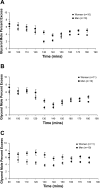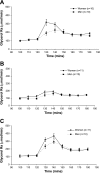Greater systemic lipolysis in women compared with men during moderate-dose infusion of epinephrine and/or norepinephrine
- PMID: 19407251
- PMCID: PMC2711790
- DOI: 10.1152/japplphysiol.90812.2008
Greater systemic lipolysis in women compared with men during moderate-dose infusion of epinephrine and/or norepinephrine
Abstract
Women have lower circulating catecholamine levels during metabolic perturbations, such as exercise or hypoglycemia, but similar rates of systemic lipolysis. This suggests women may be more sensitive to the lipolytic action of catecholamines, while maintaining similar glucoregulatory effects. The aim of the present study, therefore, was to determine whether women have higher rates of systemic lipolysis compared with men in response to matched peripheral infusion of catecholamines, but similar rates of glucose turnover. Healthy, nonobese women (n = 11) and men (n = 10) were recruited and studied on 3 separate days with the following infusions: epinephrine (Epi), norepinephrine (NE), or the two combined. Tracer infusions of glycerol and glucose were used to determine systemic lipolysis and glucose turnover, respectively. Following basal measurements of substrate kinetics, the catecholamine infusion commenced, and measures of substrate kinetics continued for 60 min. Catecholamine concentrations were similarly elevated in women and men during each infusion: Epi, 182-197 pg/ml and NE, 417-507 pg/ml. There was a significant sex difference in glycerol rate of appearance and rate of disappearance with the catecholamine infusions (P < 0.0001), mainly due to a significantly greater glycerol turnover during the first 30 min of each infusion: glycerol rate of appearance during Epi was only 268 +/- 18 vs. 206 +/- 21 micromol/min in women and men, respectively; during NE, only 173 +/- 13 vs. 153 +/- 17 micromol/min, and during Epi+NE, 303 +/- 24 vs. 257 +/- 21 micromol/min. No sex differences were observed in glucose kinetics under any condition. In conclusion, these data suggest that women are more sensitive to the lipolytic action of catecholamines, but have no difference in their glucoregulatory response. Thus the lower catcholamine levels observed in women vs. men during exercise and other metabolic perturbations may allow women to maintain a similar or greater level of lipid mobilization while minimizing changes in glucose turnover.
Figures




Similar articles
-
Adrenergic control of lipolysis in women compared with men.J Appl Physiol (1985). 2014 Nov 1;117(9):1008-19. doi: 10.1152/japplphysiol.00003.2014. Epub 2014 Sep 4. J Appl Physiol (1985). 2014. PMID: 25190743 Free PMC article.
-
Effect of the dietary supplement Meltdown on catecholamine secretion, markers of lipolysis, and metabolic rate in men and women: a randomized, placebo controlled, cross-over study.Lipids Health Dis. 2009 Aug 5;8:32. doi: 10.1186/1476-511X-8-32. Lipids Health Dis. 2009. PMID: 19656409 Free PMC article. Clinical Trial.
-
Influence of circulating NE and Epi on adipose tissue vascular resistance and lipolysis in humans.Am J Physiol. 1983 Sep;245(3):H447-52. doi: 10.1152/ajpheart.1983.245.3.H447. Am J Physiol. 1983. PMID: 6614192
-
Interaction of free fatty acids and epinephrine in regulating hepatic glucose production in conscious dogs.Am J Physiol Endocrinol Metab. 2003 Feb;284(2):E291-301. doi: 10.1152/ajpendo.00565.2001. Am J Physiol Endocrinol Metab. 2003. PMID: 12531743
-
Age-related changes in venous catecholamines basally and during epinephrine infusion in man.J Gerontol. 1985 Mar;40(2):133-40. doi: 10.1093/geronj/40.2.133. J Gerontol. 1985. PMID: 3973353
Cited by
-
Using Dietary Macronutrient Patterns to Predict Sarcopenic Obesity in Older Adults: A Representative Korean Nationwide Population-Based Study.Nutrients. 2021 Nov 11;13(11):4031. doi: 10.3390/nu13114031. Nutrients. 2021. PMID: 34836286 Free PMC article.
-
Sex-Specific Aspects of Skeletal Muscle Metabolism in the Clinical Context of Intensive Care Unit-Acquired Weakness.J Clin Med. 2022 Feb 5;11(3):846. doi: 10.3390/jcm11030846. J Clin Med. 2022. PMID: 35160299 Free PMC article.
-
Sexual dimorphism in cardiometabolic health: the role of adipose tissue, muscle and liver.Nat Rev Endocrinol. 2021 Jan;17(1):47-66. doi: 10.1038/s41574-020-00431-8. Epub 2020 Nov 10. Nat Rev Endocrinol. 2021. PMID: 33173188 Review.
-
Lack of Day/Night variation in fibroblast growth factor 21 levels in young healthy men.Int J Obes (Lond). 2015 Jun;39(6):945-8. doi: 10.1038/ijo.2014.215. Epub 2014 Dec 26. Int J Obes (Lond). 2015. PMID: 25540981
-
Risk factors for vitamin D deficiency in Abu Dhabi Emirati population.PLoS One. 2022 Feb 15;17(2):e0264064. doi: 10.1371/journal.pone.0264064. eCollection 2022. PLoS One. 2022. PMID: 35167624 Free PMC article.
References
-
- Arner P, Kriegholm E, Engfeldt P. In vivo interactions between beta-1 and beta-2 adrenoceptors regulate catecholamine tachyphylaxia in human adipose tissue. J Pharmacol Exp Ther 259: 317–322, 1991. - PubMed
-
- Bartness TJ, Song CK. Thematic review series: adipocyte biology. Sympathetic and sensory innervation of white adipose tissue. J Lipid Res 48: 1655–1672, 2007. - PubMed
-
- Berk MA, Clutter WE, Skor D, Shah SD, Gingerich RP, Parvin CA, Cryer PE. Enhanced glycemic responsiveness to epinephrine in insulin-dependent diabetes mellitus is the result of the inability to secrete insulin. Augmented insulin secretion normally limits the glycemic, but not the lipolytic or ketogenic, response to epinephrine in humans. J Clin Invest 75: 1842–1851, 1985. - PMC - PubMed
-
- Carter SL, Rennie C, Tarnopolsky MA. Substrate utilization during endurance exercise in men and women after endurance training. Am J Physiol Endocrinol Metab 280: E898–E907, 2001. - PubMed
-
- Casazza GA, Jacobs KA, Suh SH, Miller BF, Horning MA, Brooks GA. Menstrual cycle phase and oral contraceptive effects on triglyceride mobilization during exercise. J Appl Physiol 97: 302–309, 2004. - PubMed
Publication types
MeSH terms
Substances
Grants and funding
LinkOut - more resources
Full Text Sources
Medical

